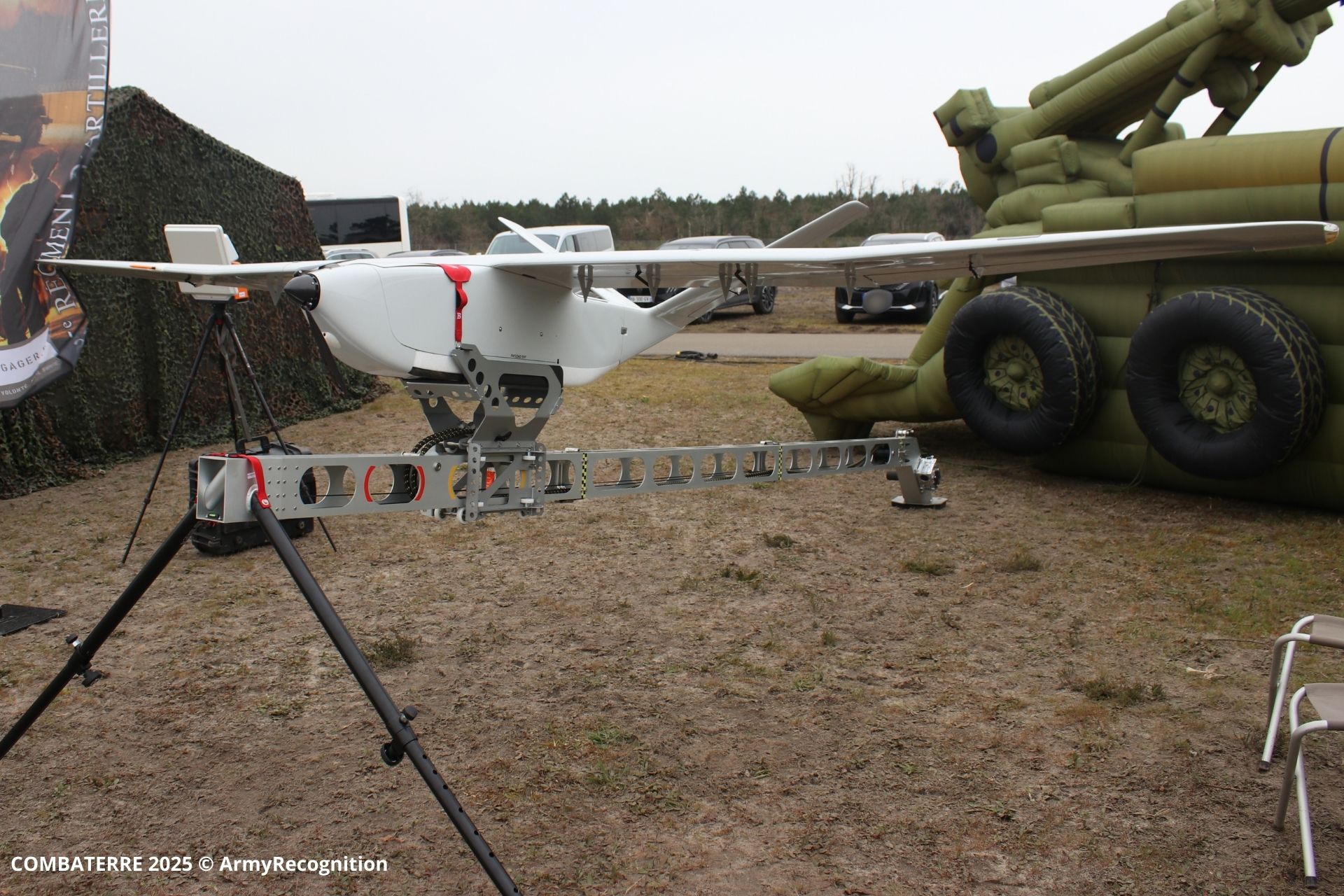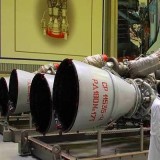Delair DT46 Drone Enhances ISR Target Acquisition and Fire Support in French Artillery Units

{loadposition bannertop}
{loadposition sidebarpub}
As modern conflicts demand increasingly rapid technological adaptability, the French Army is embracing a renewed approach to innovation, as illustrated by the upcoming integration of the DT46 tactical drone developed by Delair. Already tested by specialized units such as the 35th Parachute Artillery Regiment and the 93rd Mountain Artillery Regiment, fifty units are expected to be delivered in 2025. This development reflects a transformation in the acquisition and operational use of drones in a security environment marked by rising instability and accelerated innovation cycles.
Follow Army Recognition on Google News at this link
Featuring an electric propulsion system, it can operate either as a fixed-wing aircraft or in vertical take-off and landing (VTOL) mode thanks to detachable arms equipped with vertical rotors. (Picture source: Army Recognition)
Designed and self-funded by Delair, a company based in Toulouse, the DT46 is the result of an agile development process aimed at delivering fast responses to operational needs. The French Army’s Technical Section (STAT) has received two complete systems, each comprising two air vehicles, two ground control stations, and one antenna, for in-depth tactical evaluation. This initial phase has been completed, resulting in a positive report. STAT is now focusing on performance verification, testing the system’s limits and addressing key maintenance and logistical issues. A final report is expected by autumn 2024, setting the stage for potential large-scale deployment.
The DT46 stands out for its modularity and its adaptability to varied tactical environments. Featuring an electric propulsion system, it can operate either as a fixed-wing aircraft or in vertical take-off and landing (VTOL) mode thanks to detachable arms equipped with vertical rotors. This flexibility provides a flight endurance of five to six hours in fixed-wing mode and about three and a half hours in VTOL mode, with a communication range estimated between 80 and 100 kilometers. It is equipped with a French-manufactured electro-optical payload, already tested in Ukraine with reportedly positive operational feedback. Additionally, the system is certified to NATO STANAG 4609 standards, enabling full interoperability of video streams and metadata with allied digital networks.
In anticipation of full integration into the Army’s command systems, the DT46 has been designed to operate within the SCORPION ecosystem, particularly the SCORPION Combat Information System (SICS) and the ATLAS fire control system. It is also compatible with the newly introduced DRAKO ground station, which enables a single operator to manage up to ten drones or remotely controlled munitions from different manufacturers using a unified software interface. This capacity meets the increasing need to centralize command tools within complex air-ground operations networks.
Positioned above the current Mini-Drone Reconnaissance System (SMDR) in the Army’s drone hierarchy, the DT46 is not intended as a replacement but rather as a complementary capability. It will be deployed primarily within the acquisition and surveillance batteries (BAS) of artillery regiments, offering extended range, increased autonomy, and improved sensor performance. Its VTOL capability broadens tactical options, allowing commanders to operate drones regardless of terrain constraints. Eventually, each BAS could operate a combination of SMDR and DT46 systems, depending on mission requirements.
On the acquisition side, DT46’s integration is being facilitated through a new contractual framework managed by the Aeronautical Maintenance Directorate (DMAé). A framework contract awarded to Thales, Delair, EOS Technologie, and Survey Copter allows armed forces and other government entities to procure certified off-the-shelf drones quickly. This mechanism was used to acquire the first two systems evaluated by STAT. More flexible and responsive than traditional procurement processes, this model marks a shift toward faster adaptation to technological change.
While DT46 addresses current operational needs, it does not limit future options. The French Army is pursuing a strategy of successive iterations supported by ongoing technology monitoring led by STAT. This effort aligns with the development of the upcoming Light Tactical Drone System (SDTL), currently in the final stages of requirement definition. In an increasingly volatile and competitive strategic environment, the ability to quickly deploy the right equipment for upcoming missions is becoming essential.
The DT46 tactical drone reflects a new approach to acquiring and deploying ISR capabilities within the French Army. Combining modularity, endurance, and interoperability, it signals a shift in how land forces incorporate technological solutions into their operational structures. Through this project, a more agile, responsive, and open model is taking shape, adapted to the evolving challenges of contemporary military operations.

{loadposition bannertop}
{loadposition sidebarpub}
As modern conflicts demand increasingly rapid technological adaptability, the French Army is embracing a renewed approach to innovation, as illustrated by the upcoming integration of the DT46 tactical drone developed by Delair. Already tested by specialized units such as the 35th Parachute Artillery Regiment and the 93rd Mountain Artillery Regiment, fifty units are expected to be delivered in 2025. This development reflects a transformation in the acquisition and operational use of drones in a security environment marked by rising instability and accelerated innovation cycles.
Featuring an electric propulsion system, it can operate either as a fixed-wing aircraft or in vertical take-off and landing (VTOL) mode thanks to detachable arms equipped with vertical rotors. (Picture source: Army Recognition)
Designed and self-funded by Delair, a company based in Toulouse, the DT46 is the result of an agile development process aimed at delivering fast responses to operational needs. The French Army’s Technical Section (STAT) has received two complete systems, each comprising two air vehicles, two ground control stations, and one antenna, for in-depth tactical evaluation. This initial phase has been completed, resulting in a positive report. STAT is now focusing on performance verification, testing the system’s limits and addressing key maintenance and logistical issues. A final report is expected by autumn 2024, setting the stage for potential large-scale deployment.
The DT46 stands out for its modularity and its adaptability to varied tactical environments. Featuring an electric propulsion system, it can operate either as a fixed-wing aircraft or in vertical take-off and landing (VTOL) mode thanks to detachable arms equipped with vertical rotors. This flexibility provides a flight endurance of five to six hours in fixed-wing mode and about three and a half hours in VTOL mode, with a communication range estimated between 80 and 100 kilometers. It is equipped with a French-manufactured electro-optical payload, already tested in Ukraine with reportedly positive operational feedback. Additionally, the system is certified to NATO STANAG 4609 standards, enabling full interoperability of video streams and metadata with allied digital networks.
In anticipation of full integration into the Army’s command systems, the DT46 has been designed to operate within the SCORPION ecosystem, particularly the SCORPION Combat Information System (SICS) and the ATLAS fire control system. It is also compatible with the newly introduced DRAKO ground station, which enables a single operator to manage up to ten drones or remotely controlled munitions from different manufacturers using a unified software interface. This capacity meets the increasing need to centralize command tools within complex air-ground operations networks.
Positioned above the current Mini-Drone Reconnaissance System (SMDR) in the Army’s drone hierarchy, the DT46 is not intended as a replacement but rather as a complementary capability. It will be deployed primarily within the acquisition and surveillance batteries (BAS) of artillery regiments, offering extended range, increased autonomy, and improved sensor performance. Its VTOL capability broadens tactical options, allowing commanders to operate drones regardless of terrain constraints. Eventually, each BAS could operate a combination of SMDR and DT46 systems, depending on mission requirements.
On the acquisition side, DT46’s integration is being facilitated through a new contractual framework managed by the Aeronautical Maintenance Directorate (DMAé). A framework contract awarded to Thales, Delair, EOS Technologie, and Survey Copter allows armed forces and other government entities to procure certified off-the-shelf drones quickly. This mechanism was used to acquire the first two systems evaluated by STAT. More flexible and responsive than traditional procurement processes, this model marks a shift toward faster adaptation to technological change.
While DT46 addresses current operational needs, it does not limit future options. The French Army is pursuing a strategy of successive iterations supported by ongoing technology monitoring led by STAT. This effort aligns with the development of the upcoming Light Tactical Drone System (SDTL), currently in the final stages of requirement definition. In an increasingly volatile and competitive strategic environment, the ability to quickly deploy the right equipment for upcoming missions is becoming essential.
The DT46 tactical drone reflects a new approach to acquiring and deploying ISR capabilities within the French Army. Combining modularity, endurance, and interoperability, it signals a shift in how land forces incorporate technological solutions into their operational structures. Through this project, a more agile, responsive, and open model is taking shape, adapted to the evolving challenges of contemporary military operations.






